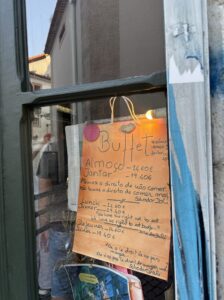The Pastel de Nata, more than just a simple delicacy, is an emblem of Portuguese convent confectionery (doçaria conventual) and a gastronomic treasure whose history is intrinsically linked to the very soul of Portugal. Its origins trace back to the 18th century, within the imposing Jerónimos Monastery in Belém, a monument that symbolizes the wealth and power of the Age of Discovery.
The Recipe’s Development: Ingenuity Born from Necessity
In Portuguese convents and monasteries, the use of egg whites was a massive, daily practice. They were essential for starching the habits and collars of monks and nuns to give them the necessary stiffness, and also played a crucial role in the clarification of wines, notably Port wine. This process resulted in an enormous surplus of egg yolks. According to Portuguese food historians, such as Alfredo Saramago, an author of works on Portuguese cuisine:
“Convent confectionery is the most sublime result of ingenuity and necessity. With privileged access to sugar from Brazil and spices from the East, and an abundance of egg yolks, the nuns and monks transformed their kitchens into true laboratories of sweet alchemy. Waste was not an option; creation was an art.”
It was in this environment of creativity and pragmatism that the monks of the Jerónimos Monastery perfected their recipe. By combining the yolks with milk, sugar, and a touch of lemon and cinnamon, they created a velvety cream, enveloped in a thin, crispy puff pastry crust—a texture that would become its unmistakable signature.
The Revolution and Survival: The Secret Leaves the Monastery
The crucial turning point occurred with the Liberal Revolution of 1820, a movement that shook the foundations of the old regime and culminated in the 1834 decree for the dissolution of all religious orders in Portugal. Faced with the loss of their livelihood, the monks, to ensure their survival, began selling their pastries at a small shop adjacent to a sugar cane refinery near the monastery.
With the monastery’s definitive closure imminent, the secret recipe was sold to a Portuguese businessman who had returned from Brazil, Domingos Rafael Alves. In 1837, he established the “Fábrica dos Pastéis de Belém” in the very same location where the monks had sold their sweets. The recipe, which remains unchanged to this day, is prepared in what is known as the “Oficina do Segredo” (The Secret Workshop). As the Portuguese newspaper Público described in a report on the topic, “the recipe is a state secret, passed down from one generation of master pastry chefs to the next, who sign a pledge of responsibility not to divulge it.”
Factors of Popularization to Worldwide Fame
The rise of the Pastel de Nata to a national and, later, global icon is due to a confluence of factors:
- Location and 19th-Century Tourism: As the official Portuguese tourism board, VisitPortugal, points out, Belém became a popular destination in the 19th century for Lisbon residents and early tourists, who arrived by steamship to visit the monuments of the Age of Discovery. The “Fábrica dos Pastéis de Belém” became a mandatory stop, and the experience of eating a warm, freshly baked pastry solidified its fame.
- The Portuguese World Exhibition (1940): This grand event, organized by the Estado Novo regime to celebrate Portugal’s history, was held in Belém. The exhibition attracted millions of visitors from across the country and abroad, who discovered and fell in love with the Pastéis de Belém, elevating them to a symbol of national identity and pride.
- Expansion and Adaptation: From the mid-20th century, other bakeries in Lisbon and throughout the country began to create their own versions, known as “Pastel de Nata.” Although they didn’t have the original recipe, the quality of many of these versions helped to entrench the sweet into the daily lives of all Portuguese people.
- A Global Phenomenon: In recent decades, mass tourism and the digital era have transformed the Pastel de Nata into a global phenomenon. Its photogenic appeal and comforting flavor have made it one of the most shared sweets on social media, leading to the opening of dedicated bakeries in cities like Tokyo, London, and New York.
Today, the friendly rivalry between the purists of “Pastéis de Belém” and fans of other versions, such as those from “Manteigaria,” is a living testament to the cultural importance of this small wonder. It is not just a dessert; it is a piece of Portuguese history that you can taste.











